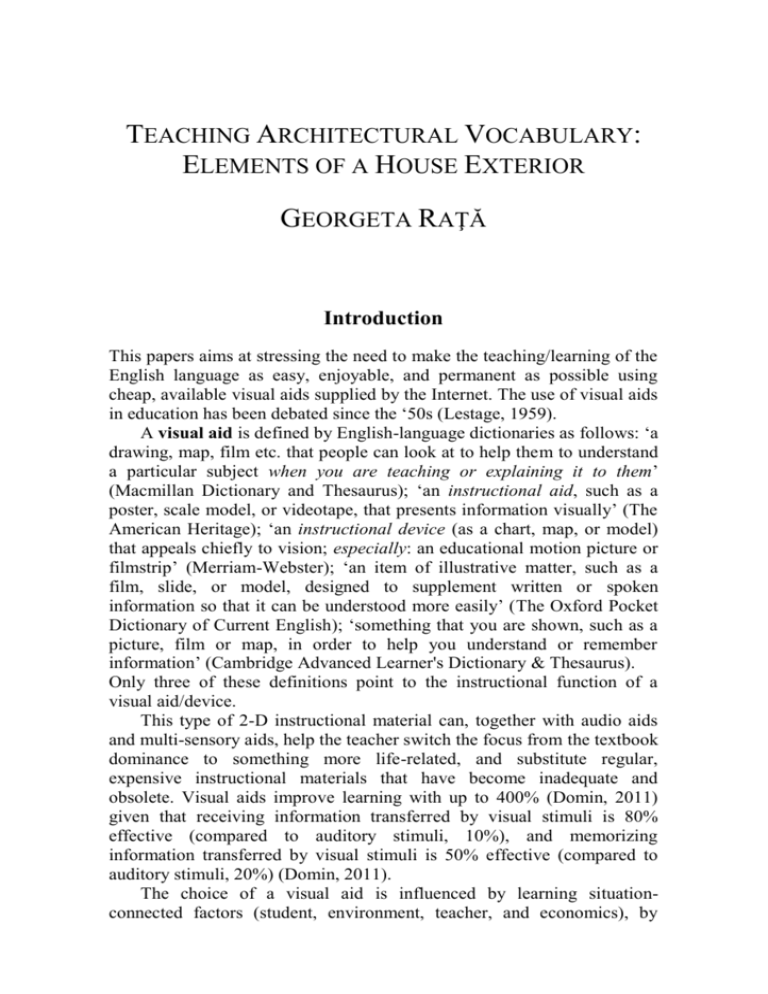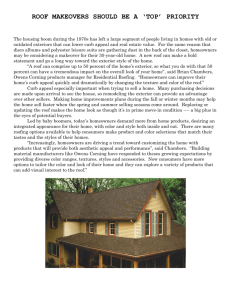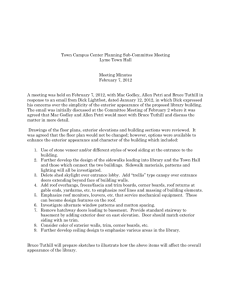Template paper ISSA 2012
advertisement

TEACHING ARCHITECTURAL VOCABULARY: ELEMENTS OF A HOUSE EXTERIOR GEORGETA RAŢĂ Introduction This papers aims at stressing the need to make the teaching/learning of the English language as easy, enjoyable, and permanent as possible using cheap, available visual aids supplied by the Internet. The use of visual aids in education has been debated since the ‘50s (Lestage, 1959). A visual aid is defined by English-language dictionaries as follows: ‘a drawing, map, film etc. that people can look at to help them to understand a particular subject when you are teaching or explaining it to them’ (Macmillan Dictionary and Thesaurus); ‘an instructional aid, such as a poster, scale model, or videotape, that presents information visually’ (The American Heritage); ‘an instructional device (as a chart, map, or model) that appeals chiefly to vision; especially: an educational motion picture or filmstrip’ (Merriam-Webster); ‘an item of illustrative matter, such as a film, slide, or model, designed to supplement written or spoken information so that it can be understood more easily’ (The Oxford Pocket Dictionary of Current English); ‘something that you are shown, such as a picture, film or map, in order to help you understand or remember information’ (Cambridge Advanced Learner's Dictionary & Thesaurus). Only three of these definitions point to the instructional function of a visual aid/device. This type of 2-D instructional material can, together with audio aids and multi-sensory aids, help the teacher switch the focus from the textbook dominance to something more life-related, and substitute regular, expensive instructional materials that have become inadequate and obsolete. Visual aids improve learning with up to 400% (Domin, 2011) given that receiving information transferred by visual stimuli is 80% effective (compared to auditory stimuli, 10%), and memorizing information transferred by visual stimuli is 50% effective (compared to auditory stimuli, 20%) (Domin, 2011). The choice of a visual aid is influenced by learning situationconnected factors (student, environment, teacher, and economics), by 2 Teaching Architectural Vocabulary lesson aim-connected factors (acquiring information, developing skills, and modifying attitudes), or by lesson strategy-connected factors (Presentation – Practice – Production, or Engage – Study – Activate). In our trial, we analysed the impact of using visual aids in the teaching of English for Special Purposes (English for Landscapists), i.e. the role of visual aids in introducing new vocabulary (the vocabulary specific to the exterior of a house). The Vocabulary Specific to the Exterior of a House According to the Visual Dictionary Online (Visual Dictionary Online), the main elements of the exterior of a house are as follows: basement window ‘opening in the wall of the bottom floor to let in light and air’, border ‘garden trimming the side of a structure or pathway’, chimney ‘part of the heating system that protrudes from the roof’, chimney pot ‘topmost part of the chimney; it is covered by a piece of metal’, cornice ‘extended section of a roof protecting the wall from rain’, dormer window ‘small window built into the roof of a structure to let in light’, downspout ‘vertical pipe through which rainwater flows’, driveway ‘private road that connects a house, garage, or other building with the street’, fence ‘barrier made of aligned wooden planks to demarcate a lot’, flower bed ‘grouping of flowers and decorative shrubs’, gable ‘upper triangular section of a wall supporting the sides of the roof’, gable vent ‘opening in the side of a gable for ventilation’, garage ‘structure used for parking vehicles’, garden path ‘walkway bordered by plants’, grade slope ‘inclination joining two different levels of the lot’, gutter ‘open pipe at the bottom of the roof collecting rainwater and channelling it to the downspout’, hedge ‘bushes planted in a row to demarcate a lot’, lawn ‘land covered by short thick grass requiring regular mowing’, lightning rod ‘metal spike attached to the roof; it protects the house by conducting lightning to the ground’, ornamental tree ‘tree planted for decorative purposes’, patio ‘outdoor area adjacent to the house that is often paved and adapted for outdoor dining’, porch ‘covered part of a house entrance protecting the door and people from the elements’, property line ‘boundary line between two pieces of property’, roof ‘house covering that protects it from the elements; it rests on the frame’, shed ‘structure used for storing garden equipment’, sidewalk ‘pedestrian walkway bordering a street’, skylight ‘window protruding through the roof to ventilate and illuminate the room below’, steps ‘outdoor staircase ending in a landing that leads to the house entrance’, and vegetable garden ‘plot of land for growing edible plants’. Georgeta Raţă 3 Testing Students in Landscaping In order to assess the importance of teaching the terms specific to the exterior of a house to students in Landscaping (a specialisation of the College of Horticulture of the Banat University of Agricultural Science and Veterinary Medicine in Timişoara, Romania), we tested two groups of students totalling 224 respondents. The control group of students were asked to match the terms related to the exterior of a house in the first column with their definitions in the second column (Table 1) without any visual aid, while the other group of were asked to do the same based also on the image of the exterior of a house. 1. Control group The control group of 112 respondents were asked to match the terms related to the exterior of a house with their definitions without any visual aid (Table 1). The results of their answers in both figures and percentage are given below (Figure 1), in the increasing order of value, with the three poorest and three best ranks marked in bold font style: border – 11 out of 112 (9.82%), gutter – 16 out of 112 (14.28%), garden path – 18 out of 112 (16.07%), dormer window – 20 out of 112 (17.85%), lawn – 30 out of 112 (26.78%), skylight – 30 out of 112 (26.78%), downspout – 32 out of 112 (28.57%), chimney – 34 out of 112 (30.35%), patio – 40 out of 112 (35.71%), fence – 41 out of 112 (36.60%), basement window – 43 out of 112 (38.39%), porch – 44 out of 112 (39.28%), hedge – 50 out of 112 (44.64%), gable – 51 out of 112 (45.53%), property line – 55 out of 112 (49.10%), driveway – 58 out of 112 (51.78%), grade slope – 59 out of 112 (52.67%), cornice – 60 out of 112 (53.57%), flower bed – 60 out of 112 (53.57%), roof – 62 out of 112 (55.35%), steps – 63 out of 112 (56.25%), vegetable garden – 66 out of 112 (58.92%), gable vent – 76 out of 112 (67.85%), chimney pot – 78 out of 112 (69.64%), lightning rod – 78 out of 112 (69.64%), sidewalk – 79 out of 112 (70.53%), shed – 80 out of 112 (71.42%), ornamental tree – 82 out of 112 (73.21%), and garage – 110 out of 112 (98.21%). It is surprising that our students could not identify border with more precision (only 11 out of 112), since they have, in their mother tongue, bordură ‘bordure, margin, strip’, but it was not surprising that they identified ornamental tree and garage, terms very similar to their Romanian counterparts (copac ornamental and garaj). 4 Teaching Architectural Vocabulary Table 1 – Test applied to the students in Landscaping Terms Definitions 1. a. 2. 3. 4. basement window border chimney chimney pot 5. 6. 7. 8. cornice dormer window downspout driveway e. f. g. h. b. c. d. 9. fence 10. flower bed i. j. 11. gable k. 12. gable vent l. 13. garage 14. garden path m. n. 15. grade slope o. 16. gutter p. 17. 18. 19. 20. q. r. s. t. hedge lawn lightning rod ornamental tree 21. patio u. 22. porch 23. property line 24. roof v. w. x. 25. shed 26. sidewalk y. z. 27. skylight 28. steps 29. vegetable garden aa. bb. cc. barrier made of aligned wooden planks to demarcate a lot boundary line between two pieces of property bushes planted in a row to demarcate a lot covered part of a house entrance protecting the door and people from the elements section of a roof protecting the wall from rain garden trimming the side of a structure or pathway grouping of flowers and decorative shrubs house covering that protects it from the elements; it rests on the frame inclination joining two different levels of the lot land covered by short thick grass requiring regular mowing metal spike attached to the roof; it protects the house by conducting lightning to the ground open pipe at the bottom of the roof collecting rainwater and channelling it to the downspout opening in the side of a gable for ventilation opening in the wall of the bottom floor to let in light and air outdoor area adjacent to the house that is often paved and adapted for outdoor dining outdoor staircase ending in a landing that leads to the house entrance part of the heating system protruding from the roof pedestrian walkway bordering a street plot of land for growing edible plants private road that connects a house, garage, or other building with the street small window built into the roof of a structure to let in light structure used for parking vehicles structure used for storing garden equipment topmost part of the chimney; it is covered by a piece of metal tree planted for decorative purposes upper triangular section of a wall supporting the sides of the roof vertical pipe through which rainwater flows walkway bordered by plants window protruding through the roof to ventilate and illuminate the room below Georgeta Raţă 5 2. Aid-tested group The aid-tested group of 112 respondents were asked to match the terms related to the exterior of a house with their definitions without any visual aid (Table 1). The results of the aid-tested group (112 respondents) in both figures and percentage are given below (Figure 2), in the increasing order of value, with the three poorest and three best ranks marked in bold font style: border – 31 out of 112 (27.67%), dormer window – 32 out of 112 (28.57%), skylight – 44 out of 112 (39.28%), garden path – 45 out of 112 (40.17%), gutter – 67 out of 112 (59.82%), downspout – 77 out of 112 (68.75%), lawn – 86 out of 112 (76.78%), grade slope – 88 out of 112 (78.57%), gable – 89 out of 112 (79.46%), patio – 92 out of 112 (82.14%), cornice – 96 out of 112 (85.71%), gable vent – 98 out of 112 (87.50%), hedge – 98 out of 112 (87.50%), steps – 99 out of 112 (88.39%), flower bed – 101 out of 112 (90.17%), lightning rod – 102 out of 112 (91.07%), basement window – 104 out of 112 (92.25%), fence – 104 out of 112 (92.25%), porch – 104 out of 112 (92.25%), vegetable garden – 104 out of 112 (92.25%), chimney – 105 out of 112 (93.75%), driveway – 105 out of 112 (93.75%), roof – 105 out of 112 (93.75%), property line – 106 out of 112 (94.64%), chimney pot – 107 out of 112 (95.53%), sidewalk – 108 out of 112 (96.42%), shed – 109 out of 112 (97.32%), ornamental tree – 110 out of 112 (98.21%), and garage – 111 out of 112 (99.10%). Border is again the poorest answer, but it was identified by a larger number of respondents. And again, ornamental tree and garage, ranked best due to their similarity with their Romanian counterparts. Conclusion The comparison of the results of the two tests (not aided visually and aided visually) shows clearly (Figure 3) that, as far as architecture is concerned, teaching the English of architecture should be done, maybe more than any other type of English for special purposes, with visual support for higher efficacy. Higher efficacy resulted, in our trial, from the fact that visual aids allowed students to take in information at their own pace, explained instructions clearly leading to fewer mistakes, helped students do things independently, helped students make choices by clearly showing the options, and reduced anxiety by giving a permanent reference. 6 Teaching Architectural Vocabulary Figure 1 – Share of term knowledge in the control group Figure 2 – Share of term knowledge in the aid-tested group Georgeta Raţă 7 Figure 3 – Comparison between the two tested groups (control and aid-tested) References Asokhia, M. O. (2009). Improvisation/Teaching Aids: Aid to Effective Teaching of English Language. International Journal of Education Science 1 (2): 79-85. Domin, Elżbieta Alicja. (2011). On Application of Visuals in Teaching English: Selected Issues. Online: http://www.publikacje.edu.pl/pdf/8385.pdf. Exterior of a House. Visual Dictionary Online. Online: http://visual.merriam-webster.com/house/location/exteriorhouse/exterior-house.php. Graham, C. R. & Walsh, M. M. (1996). Adult Education ESL Teachers Guide. Adult Education Center, Texas A & I University, Kingsville, Texas. Lavery, Clare. (2001). Language Assistant. The British Council. Lestage, A. (1959). The Use of Audio-visual Aids in Education. UNESCO Chronicle, November 1959. 1-4. Visual aid. Cambridge Advanced Learner's Dictionary & Thesaurus. Online: http://dictionary.cambridge.org/dictionary/british/visual-aid. Visual aid. Macmillan Dictionary and Thesaurus. Online: http://www.macmillandictionary.com/dictionary/british/visual-aid. Visual aid. Merriam-Webster. Online: http://www.merriamwebster.com/dictionary/visual%20aid. Visual aid. The American Heritage® Dictionary of the English Language, Fourth Edition copyright ©2000 by Houghton Mifflin Company. 8 Teaching Architectural Vocabulary Updated in 2009. Online: http://www.thefreedictionary.com/visual+aid. Visual aid. The Oxford Pocket Dictionary of Current English (2009). Online: http://www.encyclopedia.com/doc/1O999-visualaid.html.






